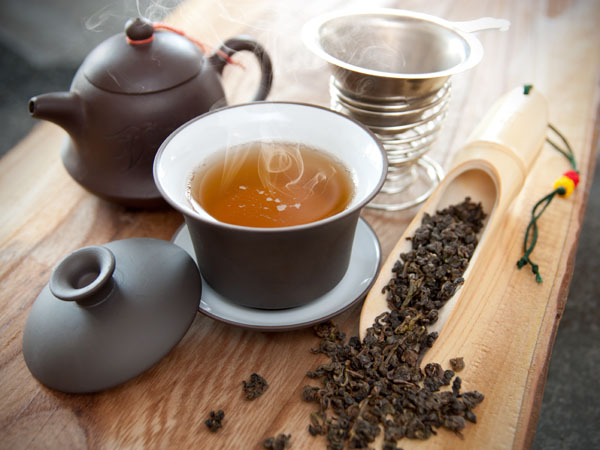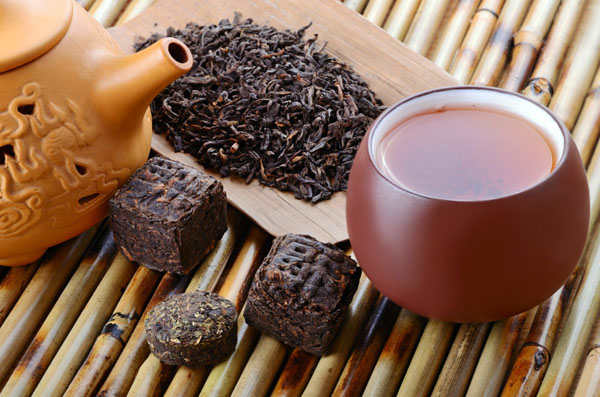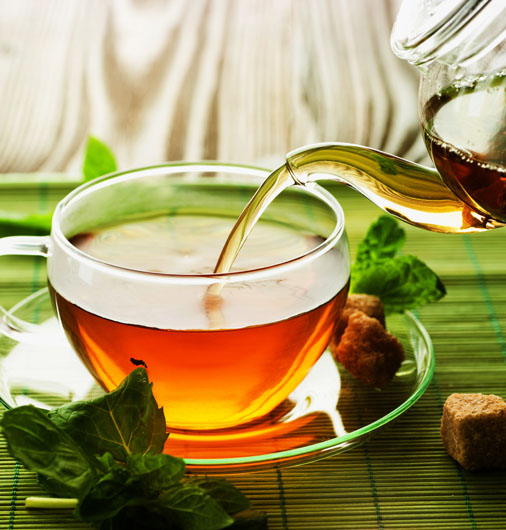5. Oolong Tea:

Oolong tea is a unique tea variety made by twisting and curling the tea leaves after the withering and oxidation process. The shape of these artisanal tea leaves depends on the tea master, which ranges from tight curls to thin strands. The rolling of leaves adds a distinct appearance, character and aroma to the brew, which can fall in between black tea and green tea.
The general rule for making Oolong tea is to seep the leaves in hot water for 2-5 minutes. The longer the seeping time, the stronger and aromatic the brew gets! The number of flavonoids also increases with the concentration to amp up the health benefits. Depending on the amount of oxidation, the caffeine percentage of Oolong may vary from batch to batch.
6. Pu’erh Tea:

Pronounced as Pu-er is a variety of un-oxidized tea which gets its name from Pu-erh, a Chinese county in the Yunnan province. The tea leaves are left to ferment for months, sometimes years to increase flavor and aroma. The older the age of tea, the higher is its price. Pu-er tea begins its life as green tea and undergoes the withering process to achieve a deeper color.
The leaves get compressed into small discs called Pu’erh cakes. One can find two types of Pu’erh teas – Raw and Ripe, where raw is a fresh batch of leaves and ripe is an aged leaf, which is quite expensive. To prepare the tea, some leaves are loosened from the cake and seeped into hot water for a few minutes until the desired color and aroma are achieved.
Pu’erh tea is known to aid in better digestion and blood circulation compared to other tea types due to the fermentation process.
7. Herbal Tea:

Herbal teas are not true teas! They are herbal infusions that result from dried herbs, spices, fruits, leaves and flowers in hot water. Herbal teas are also called Tisanes, which are aromatic and flavoursome. They are caffeine-free due to the absence of true tea leaves and popular across the world for their delicious taste and mind relaxant properties.
RELATED BEST 10 ON AMAZON:
| IMAGE | TITLE | TRENDS | SEE MORE |
|---|
 | 365 by Whole Foods Market, Tea Green Organic, 70 Count | 38888.4 | MORE VIEW |
|---|
 | Bigelow Herbal Tea 6 Flavor Variety Pack, Caffeine Free, (Pack of 6) 118 Tea Bags Total | 175813 | MORE VIEW |
|---|
 | Lipton Diet Iced Tea Mix, Lemon, Makes 15 Quarts (Pack of 2) | 10391.4 | MORE VIEW |
|---|
 | Stash Tea Variety - Caffeinated, Caffeine-Free and Decaf Bags - Assorted Sets for Women and Men - 50 Different Flavors wit... | 6312.1 | MORE VIEW |
|---|
 | Sponsored Ad - Tea Forte Warming Joy Tea Advent Calendar, Holiday Tea Gift Set of 24 Pyramid Infuser Tea Bags with Numbere... | 78.4 | MORE VIEW |
|---|
 | 365 by Whole Foods Market, Tea Black Organic, 70 Count | 21859.2 | MORE VIEW |
|---|
 | Stainless Steel Tea Infuser Filter Loose Tea Strainer Tea Ball Tea Making Tool Hanging Type | 12.6 | MORE VIEW |
|---|
 | oriarmcha 2022 Qingdao Laoshan Green Tea Loose Leaf - Chinese Cloud and Mist Green Tea Leaves 225g (8 ounce) Ziplock Resea... | 38 | MORE VIEW |
|---|
 | Twinings English Breakfast Tea K-Cup Pods for Keurig, Caffeinated, Smooth, Flavourful, Robust Black Tea, 24 Count (Pack of 1) | 187431 | MORE VIEW |
|---|
 | Bigelow Herbal Tea 6 Flavor Variety Pack, Caffeine Free, (Pack of 6) 118 Tea Bags Total | 175813 | MORE VIEW |
|---|
 | VAHDAM, Imperial White Tea Leaves from Himalayas (25 Cups) - World's Healthiest Tea Type - POWERFUL ANTI-OXIDANTS, High El... | 134343 | MORE VIEW |
|---|
 | Taylors of Harrogate Assorted Specialty Teas Box , 48 count (Pack of 1) | 112889 | MORE VIEW |
|---|
 | Harney & Sons Hot Cinnamon Spice Tea, 50 Tea Bags | 107874 | MORE VIEW |
|---|
 | Tea Forte Single Steeps Loose Leaf Tea Sampler, Assorted Variety Tea Box, 15 Single Serve Pouches (Assorted - Tea Tasting) | 75706.8 | MORE VIEW |
|---|
 | Harney & Sons Hot Cinnamon Spice Tea Tin - Black Tea with Orange & Sweet Clove - 2.67 Ounces, 30 Sachets | 57096 | MORE VIEW |
|---|
 | Taylors of Harrogate Yorkshire Gold, 160 Teabags | 54595.2 | MORE VIEW |
|---|
 | Numi Organic Tea By Mood Gift Set, 40 Count Tea Bag Assortment - Premium Organic Black, Pu-erh, Green, Mate, Rooibos & Her... | 51342.8 | MORE VIEW |
|---|
 | 365 by Whole Foods Market, Tea Green Organic, 70 Count | 38888.4 | MORE VIEW |
|---|
Tips: "Amazon, Amazon Prime, the Amazon logo and Amazon Prime logo are trademarks of Amazon.com, Inc. or its affiliates". AS AN AMAZON ASSOCIATE, WE EARN AFFILIATE COMMISSIONS FROM QUALIFYING PURCHASES.

























